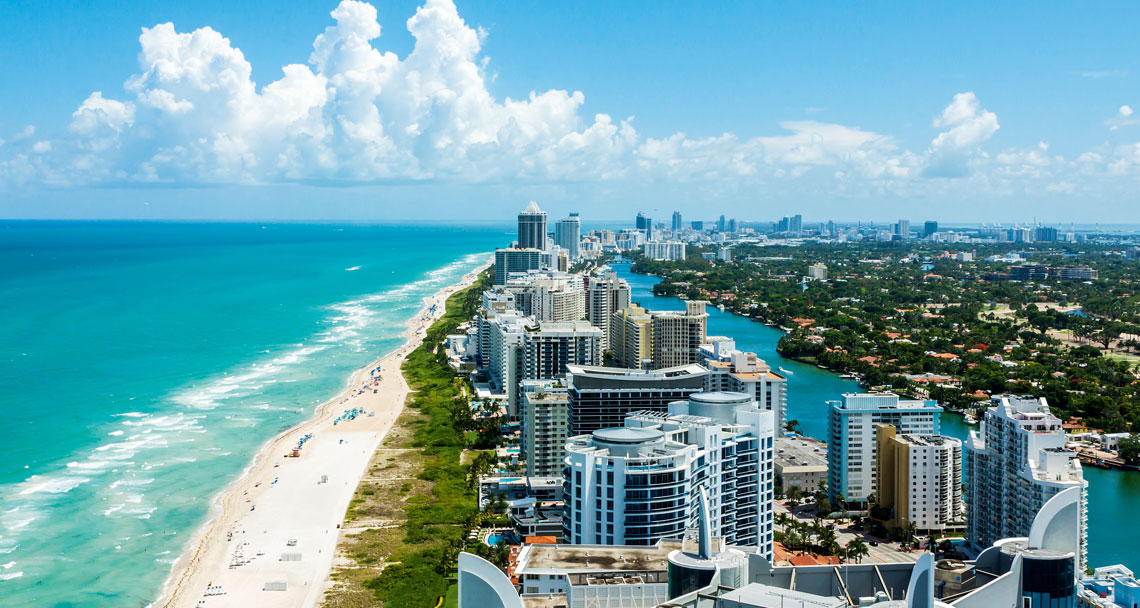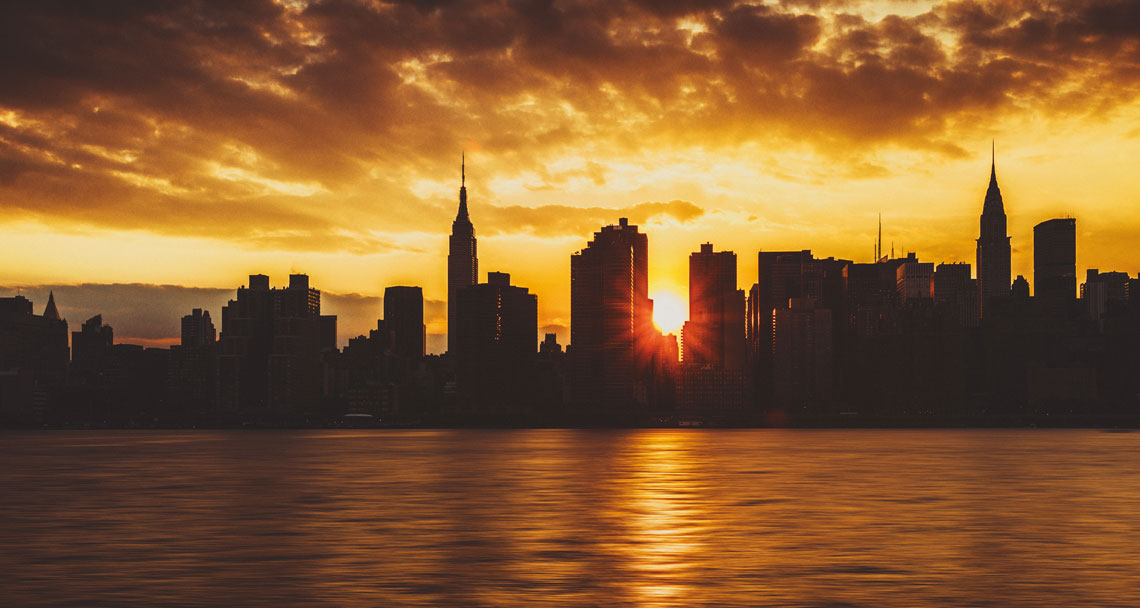Cities at risk: tackling the pressures of extreme weather
The physical impact of climate change on cities is intensifying, and is a growing concern for real estate investors. We look at the risks and how cities are adapting.
The physical risks have become the most evident impact of climate change in recent years. As an increasing number of extreme and unpredictable weather-related events hit the headlines, the scale of the effects on countries and major cities is escalating.
In February 2021, a state of emergency was declared in Texas as it experienced paralysing snowstorms and some of the lowest temperatures for 30 years. Wildfires in Australia, Brazil and the US have spread fast; California had a record four million acres burnt in 2020. In 2019, Cape Town was just 90 days from running out of water, while the Indonesian capital Jakarta was hit by monsoon floods in February 2021.
There are three categories of climate change-related disasters: climatological, with extreme temperatures causing droughts and forest fires. Hydrological, resulting in floods, landslides, and avalanches. Meteorological events, resulting in storms. While cities experience other natural disasters such as volcanoes and earthquakes, these have not been directly related to climate change.
Data from insurer Munich Re shows that the frequency and intensity of these extreme weather events is increasing. In 1980, the combined effect of hydrological, meteorological and climatological events measured 222 on Munich Re’s assessment scale. By 2000, that figure was 474, and had climbed to 760 by 2019. In that year, hydrological events alone hit a level of 360.
This means that many global cities are at risk, particularly coastal ones that are exposed to increases in sea levels, storm activity and associated flooding. It is a risk that is now a central plank to the survival of many cities as they recognise the need to play an active role in formulating climate change mitigation and adaptation policies. It is also taking greater priority in real estate investors’ decision-making. Both the physical risk to their assets at a city- and asset-allocation level, and the mitigation strategy of the city in which they’re located are increasingly important.
Climate-risk analysis has become part of the decision-making process for investors
A robust climate risk analysis has now become part of the due diligence and other investment decision-making processes for many investors. “For physical risks, what we’re trying to do is be able to set out in our underwriting process how those physical risks might impact on liquidity, rental growth and insurability and insurance costs,” says Abigail Dean, Global Head of Strategic Insights for Nuveen Real Estate.
Extreme weather events associated with climate often result in substantial repair costs and potential for increased insurance premiums. In addition, operating costs may increase if, for example, temperatures continue to rise and properties need to mitigate them.
This can also have an impact on the attractiveness of cities for investors. Analysis from the Lloyd’s City Risk Index details those at most risk calculated by losses in gross domestic product (GDP) from 22 threats, including some climate-related areas. The results show that many cities actually face multiple risks. Tokyo appears in the top 10 for all four categories: drought, heatwaves, floods and storms. While its large GDP plays a significant part in its rankings, the city appears prone to weather-related disasters. There are also the non-weather related threats of large earthquakes and the eruption of Mount Fuji, which are serious concerns.
Many investors have already started to extend their due diligence to the resilience of cities and how they will lead on climate change adaption. “Where we’ve identified cities that are more vulnerable, we’ve asked [our consultants] to give us an idea of what level of investment we would expect to see from the city authorities or from the federal government on protecting against those risks, says Dean. “Then, we can start to track if that money is actually being spent. If it isn’t, that would obviously then make that location riskier.”
For real estate investors, factoring in physical climate risks will continue to alter the decision-making process for new investments as they need to understand the future costs – and their impact on returns – to ensure individual assets are resilient to extreme weather. This additional layer of understanding a city’s ability to cope brings further complexity and could shift capital based on a city’s ability to adapt.
Innovative Ideas to Mitigate Risk

- Amsterdam is using city management as a tool and has become the first city to adopt the doughnut economy, which draws upon UN Sustainable Development Goals to set out the minimum needed to live a good life in the city.
- Jakarta has postponed its $33bn relocation of the sinking capital city to the island of Borneo due to Covid-19. Originally, a state palace, government buildings and transport infrastructure were meant to be ready for 2024.
- Seville has found an innovative way to create a different kind of juice from unwanted oranges that fall in the city’s streets. It is using the methane produced as its famous oranges ferment to generate clean electricity.
- Miami, one of the most vulnerable cities to storms, flooding and seawater rise, is investing $4bn in its “Rising Above” plan to elevate roads, build new sea walls and install pump and drainage systems.
We look at which cities have the most GDP at risk from four different climate-related natural disasters. We also give examples of how two cities are acting to mitigate each risk, one from the top 10 at risk and another with an innovative solution.
Heatwaves
New York has the most GDP value to lose in terms of heatwaves. However, it is Paris, second on the list, that has been a leading city for its action to counter the risk of heatwaves after losing more than 700 Parisians to a deadly summer in 2003.
In its Resilience Strategy of 2017, the French capital set out plans to transform the city’s 761 schools into green islands that function as urban oases of cooler temperatures. By 2040, all of Paris’s schools will be refurbished with green roofs, rainwater capture facilities, cooling fountains and trees. These cool spots also have the benefit of boosting the city’s low levels of green space; currently around 10% versus some 33% in London.
Meanwhile, the city of Ahmedabad in India estimates that it has avoided more than 1,100 heat-related deaths annually since it put in place a Heat Action Plan in 2013. The plan is about adaptive efforts such as using white lime wash to provide a simple and cost-effective solution to extreme heat in the city, as well as community engagement, inter-agency coordination and having an early warning system in place.
Drought
For cities in the US such as Los Angeles, which ranks highest on the at-risk drought rankings, adapting to water shortages has been a decades-long battle. This led to initiatives such as California’s Orange County Water District distributing treated sewage as drinking water from the mid-1970s. The state has now also passed a law to protect its aquifers; an attempt to reverse groundwater deficits by allowing rain to refill aquifers but also by shrinking demand. California will fund better data and look to identify the best places to replenish aquifers by, for example, flooding farm fields.
In Phoenix, water security is high on the agenda as drought could cause part of the state to lose its Colorado River supply in the next five years. The city’s plan is to decouple water use with growth by setting long-term goals, finding opportunities in wastewater management and looking to nature-based solutions. It will fund these ambitions by issuing bonds for municipal water infrastructure.
Floods
Shanghai, ranking ninth in the flood risk rankings and one of the most flood-prone cities in the world, is part of a wider adaptation policy by China called the sponge city strategy. Initiated in 2014, it requires that 80% of urban land is able to absorb or reuse 70% of storm water. Shanghai is also reducing its exposure to rising seas through an ambitious 520km of protective seawalls that stretch across the Hangzhou Bay and encircle the islands of Chongming, Hengsha and Changxing.
Shanghai is reducing its exposure to rising sea levels with 520km of protective sea walls.
Rotterdam does not feature in the top 10 for good reason: the Dutch have made it a resilient delta city through learning to live with the water. It erected its first dam in the 13th century, and new canals were built in the 1850s to improve water quality and reduce epidemic outbreaks of cholera. Today, it protects the city’s population from floods with no impediments to sea traffic. The city is also contending with excessive rainwater and has created water squares which have alternative uses in drier times. At Benthemplein, three such squares can collect rainwater when needed but can also be used as amphitheatres, basketball and volleyball courts and skateboarding rinks.
Storms
With Tokyo at risk from all four types of extreme weather featured, it is no surprise that it has led in innovative solutions for climate adaption – in this case excess water from typhonic rains and rising rivers. Its flagship defence is a ‘floodwater cathedral’ 22m below ground as part of a $2 billion Metropolitan Area Outer Underground Discharge Channel (MAOUDC) with 6.3km of tunnels and chambers.
Across the world in Dominica, the Caribbean island is attempting to make itself hurricane-proof after the devastation caused by Hurricane Maria in 2017. The island’s approach was not just to build back hurricane-proof buildings, but also to diversify the tourism and agricultural economy; for example, expanding the goods it grows from its primary export of bananas. Its efforts are governed by the Climate Resilience Execution Agency for Dominica (CREAD), which spans the initiatives from building codes to new geothermal energy plans and transportation infrastructure.

“That risk to urban locations also extends to more surprising places, such as the US”
While cities need to ensure buildings are resilient to climate risks, these cities will be nothing if the people in them are leaving. Sadly, the displacement of people through climate change is an increasing problem globally. This is both displacements following disasters or the insidious impact of slow onset environmental change as people’s livelihoods falter as they struggle to get access to water, food or shelter.
The issue of disaster displacement risk is most associated with Asia-Pacific with its combination of climate hazards and densely populated cities. “What you are seeing is a concentration of economic activity in these cities,” says Alexandra Bilak, director of the Internal Displacement Monitoring Centre (IDMC), which provides data, analysis and expertise on the topic to inform policy, reduce risk and improve the lives of displaced people. “Mostly, these cities are organised on coastal areas, and the disaster displacement risk is also predominantly concentrated in urban areas.”
That risk to urban locations also extends to more surprising places, such as the US. “We’ve seen the US unexpectedly coming up as one of the top three or four countries with the largest number of new disaster displacements every year,” says Bilak. During the wildfires in California, people lost everything and had no insurance cover.
France and the UK are also affected by displacement but to a much lesser extent.
One problem occurs when communities are repeatedly affected by extreme weather events. “It’s insidious. It gradually erodes people’s coping capacities, their livelihoods, and it pushes them gradually into poverty,” says Bilak. Disaster displacement risks disproportionately affect marginalised or poorer groups, both for being less prepared beforehand and less adequately supported by governments in the aftermath.
There is also a vicious cycle for cities as rural areas, too, continue to be affected by climate risks. “People who are losing their livelihoods in rural areas are migrating to the city. So, the city itself is then having to absorb more and more people,” says Bilak. “I saw it in Bangladesh, where the coastline is receding and people are moving to Dhaka. Of course, they’re not settling in beautifully built villas in the city centre. They are settling in the slums, in informal settlements and becoming, arguably, even more at risk than they were in the coastal areas.”
Places that have adapted well are those which have long faced an existential threat from climate risks – the small island states in the Pacific, for example. They have taken on what are often complex and sensitive projects to move communities inland.
For most countries, Bilak says the message is getting through to not build homes in hazard-prone areas and to adapt better building practices and standards, but this is not always a joined-up or urgent conversation. “Maybe they are still thinking about it in a localised ad-hoc way, but I think this is something that is going to become more prominent and urgent in the coming decades.” www.internal-displacement.org



